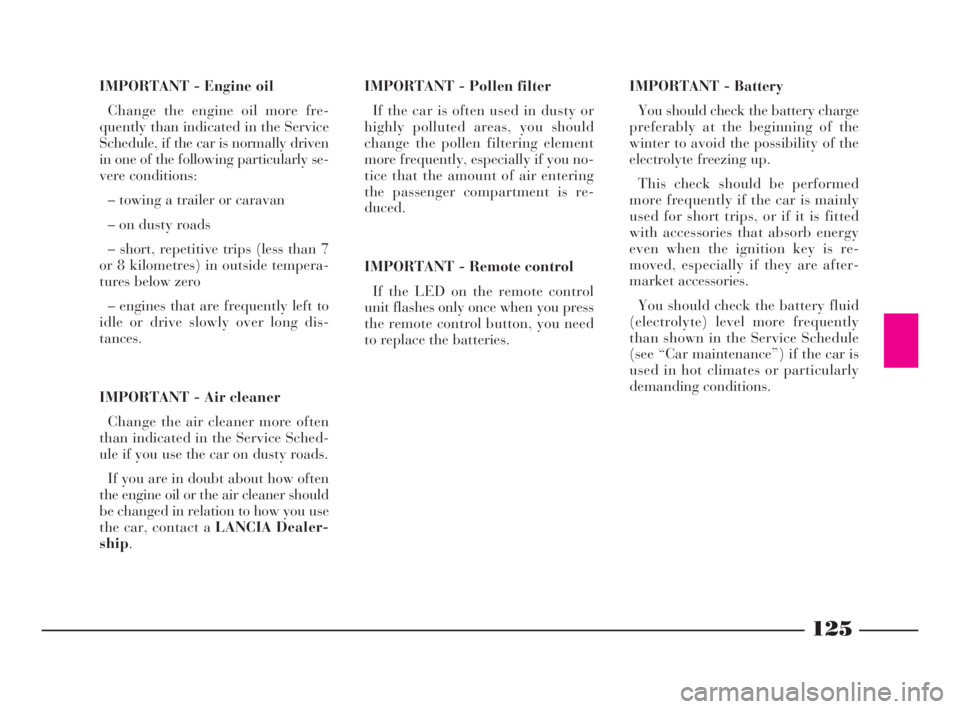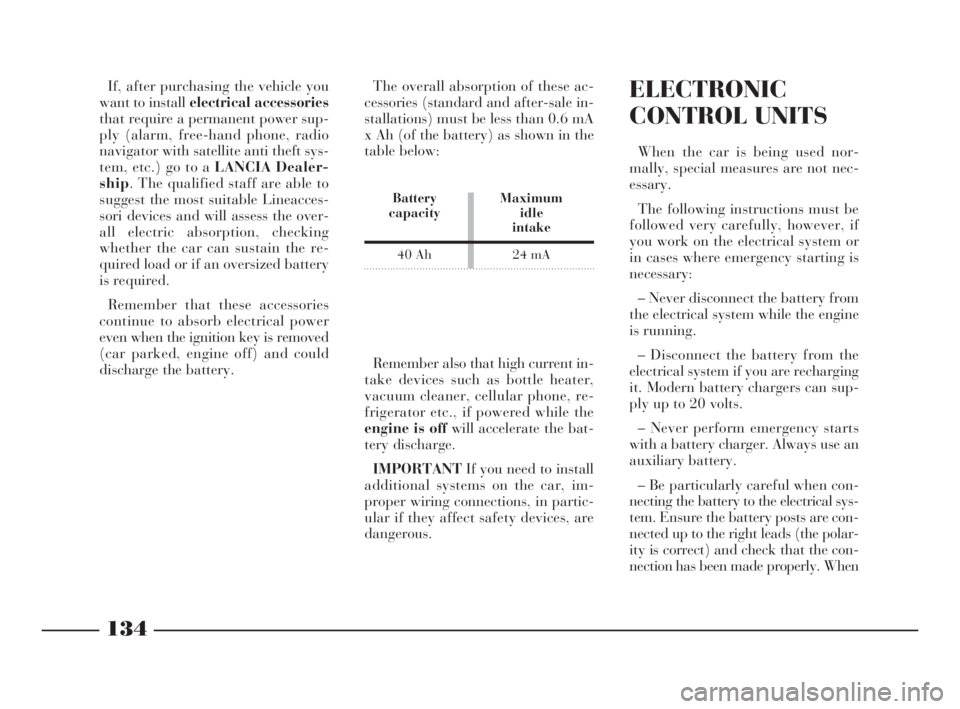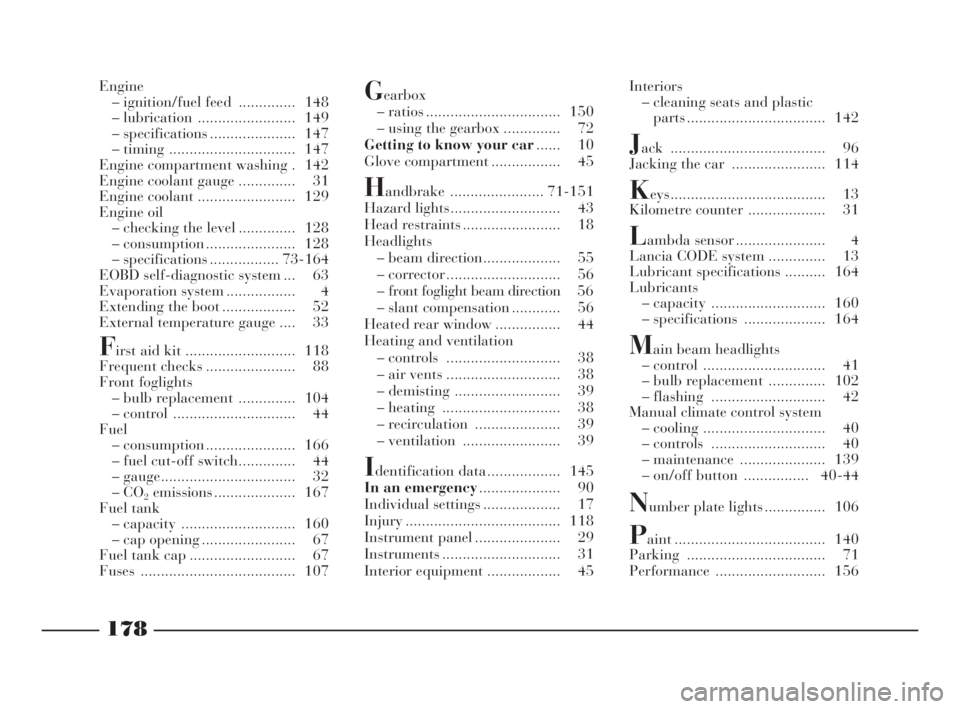ignition Lancia Ypsilon 2002 Owner handbook (in English)
[x] Cancel search | Manufacturer: LANCIA, Model Year: 2002, Model line: Ypsilon, Model: Lancia Ypsilon 2002Pages: 191, PDF Size: 2.45 MB
Page 120 of 191

117
fG
While the car is being
towed with the engine off,
remember that the brake
pedal and steering will require
more effort as you no longer have
the benefit of the brake booster
and power steering. Do not use
flexible cables to tow. Avoid jerk-
ing. Whilst towing, ensure that the
coupling to the car does not dam-
age the surrounding components.Do not extract the igni-
tion key during towing;
leave it at MAR, to prevent
the steering lock engaging and,
provided the electrical system is
not damaged, keep the brake lights
and direction indicators working.
When the ignition key is re-
moved, the steering lock will cut in
thus preventing the steering wheel
from being turned.IF AN ACCIDENT
OCCURS
– It is important to keep calm.
– If you are not directly involved,
stop at least ten metres away from the
accident.
– If you are on a motorway do not
obstruct the emergency lane with your
car.
– Turn off the engine and turn on
the hazard lights.
– At night, illuminate the scene of
the accident with your headlights.
– Act carefully, you must not risk
being run over.
– Mark the accident by putting the
red triangle at the regulatory distance
from the car where it can be clearly
seen.
– If the doors are jammed, do not try
to leave the car by breaking the glass
of the windscreen as the glass is strat-
ified. Side windows and the rear win-
dow can be broken more easily.
4C090-119 ING 13-03-2008 12:51 Pagina 117
Page 121 of 191

118
fG
– Call the emergency services mak-
ing the information you give as accu-
rate as you can. On the motorway use
the special column-mounted emer-
gency phones.
– Remove the ignition keys of the ve-
hicles involved.
– If you can smell petrol or other
chemicals, do not smoke and make
sure all cigarettes are extinguished.
– Use a fire extinguisher, blanket,
sand or earth to put out fires no mat-
ter how small they are. Never use
water.
– In pile-ups on the motorway, par-
ticularly when the visibility is bad,
there is a high risk of other vehicles
running into those already immobile.
Get out of the car immediately and
take refuge behind the guard rail.IF ANYONE IS INJURED
– Never leave the injured person
alone. The obligation to provide as-
sistance exists even for those not di-
rectly involved in the accident.
– Do not congregate around the in-
jured person.
– Reassure the injured person that
help is on its way and will arrive soon.
Stay close by to calm him/her down
in case of panic.
– Unfasten or cut seat belts holding
injured parties.
– Do not give an injured person any-
thing to drink.
– Never move an injured person ex-
cept in the following cases.
– Pull the injured person from the
car only if it risks catching fire, it is
sinking in water or is likely to fall over
a cliff or similar. Do not pull his/her
arms or legs, never bend the head
and, as far as possible, keep the body
horizontal.FIRST-AID KIT
The first-aid kit must at least con-
tain(fig. 45):
– sterile gauze for covering and
cleansing wounds
– bandages of different widths
– antiseptic plasters of different sizes
– a roll of plaster
– a packet of cotton wool
– a bottle of disinfectant
– a packet of paper handkerchiefs
– a pair of scissors with rounded tips
– a pair of pincers
– two haemostatic loops.
4C090-119 ING 13-03-2008 12:51 Pagina 118
Page 128 of 191

125
G
IMPORTANT - Battery
You should check the battery charge
preferably at the beginning of the
winter to avoid the possibility of the
electrolyte freezing up.
This check should be performed
more frequently if the car is mainly
used for short trips, or if it is fitted
with accessories that absorb energy
even when the ignition key is re-
moved, especially if they are after-
market accessories.
You should check the battery fluid
(electrolyte) level more frequently
than shown in the Service Schedule
(see “Car maintenance”) if the car is
used in hot climates or particularly
demanding conditions. IMPORTANT - Engine oil
Change the engine oil more fre-
quently than indicated in the Service
Schedule, if the car is normally driven
in one of the following particularly se-
vere conditions:
– towing a trailer or caravan
– on dusty roads
– short, repetitive trips (less than 7
or 8 kilometres) in outside tempera-
tures below zero
– engines that are frequently left to
idle or drive slowly over long dis-
tances.
IMPORTANT - Air cleaner
Change the air cleaner more often
than indicated in the Service Sched-
ule if you use the car on dusty roads.
If you are in doubt about how often
the engine oil or the air cleaner should
be changed in relation to how you use
the car, contact a LANCIA Dealer-
ship.IMPORTANT - Pollen filter
If the car is often used in dusty or
highly polluted areas, you should
change the pollen filtering element
more frequently, especially if you no-
tice that the amount of air entering
the passenger compartment is re-
duced.
IMPORTANT - Remote control
If the LED on the remote control
unit flashes only once when you press
the remote control button, you need
to replace the batteries.
4C120-143 ING 11-03-2008 12:01 Pagina 125
Page 137 of 191

134
G
If, after purchasing the vehicle you
want to install electrical accessories
that require a permanent power sup-
ply (alarm, free-hand phone, radio
navigator with satellite anti theft sys-
tem, etc.) go to a LANCIA Dealer-
ship. The qualified staff are able to
suggest the most suitable Lineacces-
sori devices and will assess the over-
all electric absorption, checking
whether the car can sustain the re-
quired load or if an oversized battery
is required.
Remember that these accessories
continue to absorb electrical power
even when the ignition key is removed
(car parked, engine off) and could
discharge the battery.The overall absorption of these ac-
cessories (standard and after-sale in-
stallations) must be less than 0.6 mA
x Ah (of the battery) as shown in the
table below:ELECTRONIC
CONTROL UNITS
When the car is being used nor-
mally, special measures are not nec-
essary.
The following instructions must be
followed very carefully, however, if
you work on the electrical system or
in cases where emergency starting is
necessary:
– Never disconnect the battery from
the electrical system while the engine
is running.
– Disconnect the battery from the
electrical system if you are recharging
it. Modern battery chargers can sup-
ply up to 20 volts.
– Never perform emergency starts
with a battery charger. Always use an
auxiliary battery.
– Be particularly careful when con-
necting the battery to the electrical sys-
tem. Ensure the battery posts are con-
nected up to the right leads (the polar-
ity is correct) and check that the con-
nection has been made properly. When Remember also that high current in-
take devices such as bottle heater,
vacuum cleaner, cellular phone, re-
frigerator etc., if powered while the
engine is off will accelerate the bat-
tery discharge.
IMPORTANTIf you need to install
additional systems on the car, im-
proper wiring connections, in partic-
ular if they affect safety devices, are
dangerous.
Battery Maximum
capacity idle
intake
40 Ah 24 mA
4C120-143 ING 11-03-2008 12:01 Pagina 134
Page 138 of 191

135
G
SPARK PLUGS
The cleanness and soundness of the
spark plugs are very important for
keeping the engine efficient and pol-
luting emissions down.
The appearance of the spark plug
(fig. 6), if examined by an expert eye,
is a good way of pinpointing a mal-
function even if it has nothing to do
with the ignition system. Therefore if
the engine has problems, it is impor-
tant to have the spark plugs checked
at a LANCIA Dealership.The spark plugs must be
changed at the times spec-
ified in the Service Sched-
ule. Only use the type of plugs in-
dicated: if the heat ratio is less
than required or the life specified
is not guaranteed, problems can
arise.
the battery is reconnected, the injec-
tion/ignition system control unit must
readapt its internal parameters; conse-
quently performance may not be opti-
mal during the first few kilometres af-
ter reconnecting the battery.
– Do not connect or disconnect the
terminals of the electronic units while
the ignition key is at MAR.
– Do not check polarity through
sparking.
– Disconnect the electronic units if
you are electrically welding the car
body. Remove the units if tempera-
tures exceed 80°C (special operations
on the bodywork etc.).
IMPORTANTIf the radio or car
alarm systems are not installed cor-
rectly, they can interfere with the
working of the electronic control units.
Modifications or repairs
to the electrical system
that are performed incor-
rectly and do not take into account
the system’s technical features can
result in malfunctions with the
risk of fire.
Versions Type of spark plug
1.2ChampionRC10YCC
NKG BKR5EZ
1.216VNGK DCPR8E-N
fig. 6
P4C00308
4C120-143 ING 11-03-2008 12:01 Pagina 135
Page 144 of 191

141
G
IMPORTANTCars with optional
“Kaleidos” options (non-standard
personalised paint colours), can be re-
paired in exactly the same way as
other cars painted with standard
colours at your LANCIA Dealership.To wash the car properly:
1)Remove the aerial from the roof
to prevent damaging it when washing
the car in an automatic carwash.
2)Wet the body using a low pressure
jet of water.
3)Wipe a sponge with a slightly
soapy solution over the bodywork,
frequently rinsing the sponge.
4)Rinse well with water and dry
with a jet of air or a chamois leather.
When drying the car, be careful to
get at those parts which are not so
easily seen e.g. the door frames, bon-
net and around the headlights where
water can most readily collect. You
are advised not to take the car into a
closed area immediately, but to leave
it out in the open so any water left can
evaporate more easily.
Do not wash the car after it has been
parked in the sun or while the bonnet
is hot: it could take the shine off the
paint.
External plastic parts must be
cleaned following the usual car wash-
ing procedure. As far as possible avoid parking your
car under trees; the resinous sub-
stances which often drop from certain
types of trees could dull the paint and
increase the possibility of rusting.
IMPORTANTBird droppings must
be washed off immediately and with
great care as their acid is particularly
aggressive.
Detergents pollute water.
For this reason, the car
must be washed in an area
equipped for the collection and
purification of the liquids used
while washing.
IMPORTANTWashing is to be car-
ried out with the engine cold and the
ignition key on STOP. After washing
make sure that the various protections
(rubber sheaths and other guards)
have not moved from their positions
or been damaged.
4C120-143 ING 11-03-2008 12:01 Pagina 141
Page 145 of 191

Detergents pollute water.
The car must therefore be
washed in an area
equipped for the collection and
purification of the liquids used
while washing.
IMPORTANTThe car should be
washed while the engine is cold and
with the ignition key at STOP. After
washing the car, make sure that the
various protections (e.g. rubber boots
and various guards) have not been re-
moved or damaged.
142
G
Windows
Use specific window cleaners to
clean the windows. Use very clean
cloths to avoid scratching the glass or
damaging its transparency.
IMPORTANTTo prevent damage
to the electric heater elements, wipe
the inside of the heated rear window
gently in the same direction as the el-
ements.
Engine compartment
At the end of each winter season,
carefully clean the engine compart-
ment. Be careful not to direct the jet
of water on the electronic control
units. Have this done at a garage.INTERIORS
From time to time check that water
has not collected under the mats
(from dripping shoes, umbrellas etc.)
which could cause the steel to rust.
CLEANING THE SEATS
AND FABRIC UPHOLSTERY
– Remove the dust with a soft brush
or a vacuum cleaner.
– Rub the seats with a sponge moist-
ened in a solution of water and neu-
tral detergent.
4C120-143 ING 11-03-2008 12:01 Pagina 142
Page 151 of 191

148
G
FUEL SUPPLY / IGNITION
1.2 versions
Integrated electronic injection and
ignition system: a single electronic
control unit controls both functions.
It processes both the time the injec-
tion lasts (for fuel metering) and the
spark advance angle.
– Type: ......................Multi-point.
– Method of measuring the amount
of aspirated air for petrol metering:
“Speed density” (*).
– “Closed loop”: information on
combustion for correct petrol meter-
ing achieved by means of two lambda
sensors (one upstream and the other
downstream with respect to the catal-
yser).– Electric petrol pump: in-tank.
– Injection pressure: ......... 3.5 bar.
– Air cleaner: dry-type with paper
filter element.
– Firing order: ................1-3-4-2.
– Engine idling speed: 750±50 rpm.
– Spark plugs:
Champion.................RC10YCC
NGK ........................... BKR5EZ1.216Vversions
Integrated electronic injection and
ignition system: a single electronic
control unit controls both functions.
It processes both the time the injec-
tion lasts (for fuel metering) and the
spark advance angle.
– Type: ......................Multi-point.
– Method of measuring the amount
of aspirated air for “Speed density”
petrol metering (*).
– “Closed loop”: information on
combustion for correct petrol meter-
ing achieved by means of two lambda
sensors (one upstream and the other
downstream with respect to the catal-
yser).
– Electric petrol pump: in-tank.
4C144-167 ING 11-03-2008 12:02 Pagina 148
Page 158 of 191

155
G
ELECTRICAL
SYSTEM
Power supply voltage: 12 Volts.
BATTERY
With negative earth.STARTER MOTOR
With pinion and free wheel. En-
gagement through electromagnet op-
erated by the ignition key.
Power output:
All versions ......................... 0.8 kW
ALTERNATOR
Rectifier bridge and built-in elec-
tronic voltage regulator. Battery be-
gins recharging as soon as the engine
starts.
Maximum rated current output:
1.2
1.216V....................................65A
All versions
with climate control ..................75A
WHEEL GEOMETRY
Front wheel toe-in measured from
rim to rim: 0±1 mm.
The figures refer to the car in full
running order.Modifications or repairs
to the electrical system
carried out incorrectly and
without bearing the features of the
system in mind can cause mal-
functions with the risk of fire.
Version Capacity 20 hr Cold crankingdischarge rate power (–18°C)
1.2 - 1.2 16V40Ah 200A
4C144-167 ING 11-03-2008 12:02 Pagina 155
Page 181 of 191

178
fdG
Interiors
– cleaning seats and plastic
parts .................................. 142
Jack ...................................... 96
Jacking the car ....................... 114
Keys...................................... 13
Kilometre counter ................... 31
Lambda sensor ...................... 4
Lancia CODE system .............. 13
Lubricant specifications .......... 164
Lubricants
– capacity ............................ 160
– specifications .................... 164
Main beam headlights
– control .............................. 41
– bulb replacement .............. 102
– flashing ............................ 42
Manual climate control system
– cooling .............................. 40
– controls ............................ 40
– maintenance ..................... 139
– on/off button ................ 40-44
Number plate lights ............... 106
Paint ..................................... 140
Parking .................................. 71
Performance ........................... 156 Engine
– ignition/fuel feed .............. 148
– lubrication ........................ 149
– specifications ..................... 147
– timing ............................... 147
Engine compartment washing . 142
Engine coolant gauge .............. 31
Engine coolant ........................ 129
Engine oil
– checking the level .............. 128
– consumption ...................... 128
– specifications ................. 73-164
EOBD self-diagnostic system ... 63
Evaporation system ................. 4
Extending the boot .................. 52
External temperature gauge .... 33
First aid kit ........................... 118
Frequent checks ...................... 88
Front foglights
– bulb replacement .............. 104
– control .............................. 44
Fuel
– consumption ...................... 166
– fuel cut-off switch.............. 44
– gauge................................. 32
–CO
2emissions .................... 167
Fuel tank
– capacity ............................ 160
– cap opening ....................... 67
Fuel tank cap .......................... 67
Fuses ...................................... 107
Gearbox
– ratios ................................. 150
– using the gearbox .............. 72
Getting to know your car...... 10
Glove compartment ................. 45
Handbrake ....................... 71-151
Hazard lights........................... 43
Head restraints ........................ 18
Headlights
– beam direction................... 55
– corrector ............................ 56
– front foglight beam direction 56
– slant compensation ............ 56
Heated rear window ................ 44
Heating and ventilation
– controls ............................ 38
– air vents ............................ 38
– demisting .......................... 39
– heating ............................. 38
– recirculation ..................... 39
– ventilation ........................ 39
Identification data .................. 145
In an emergency.................... 90
Individual settings ................... 17
Injury ...................................... 118
Instrument panel ..................... 29
Instruments ............................. 31
Interior equipment .................. 45
4C177-184 Indice ING 13-03-2008 13:31 Pagina 178